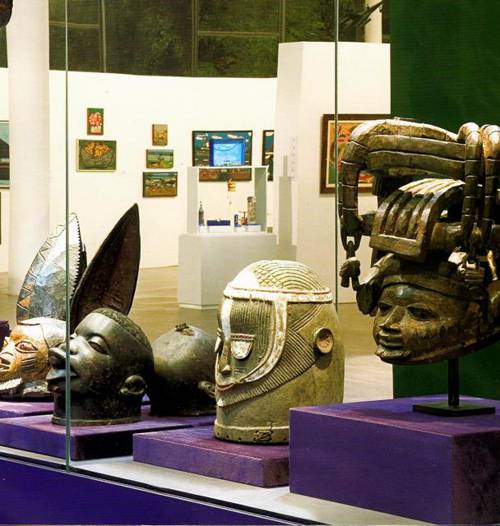
FAQ About The Impact of Afrocentric Art in Global Discourse

What is Afrocentric art?
Afrocentric art refers to creative expressions grounded in African culture and perspectives. It highlights African experiences, values, and aesthetics, aiming to celebrate African heritage and influence global cultural dialogues. This art form often includes visual arts, music, dance, and literature, emphasizing narratives that have historically been marginalized.

How has Afrocentric art influenced global cultural dialogues?
Afrocentric art has played a significant role in global cultural dialogues by bringing attention to African histories and perspectives. By showcasing diverse African cultures and challenging Eurocentric narratives, it fosters a more inclusive understanding of world history and culture. This influence promotes cultural diversity, fosters dialogue about race and identity, and enriches global artistic expressions.

Can you give examples of well-known Afrocentric artists?
Some prominent Afrocentric artists include visual artist Kehinde Wiley, whose works reimagine classic Western portraiture with African subjects; novelist Chinua Achebe, who explored post-colonial African identity in his literature; and musician Fela Kuti, a pioneer of Afrobeat music that combines African rhythms with global influences. These artists and others have had a lasting impact on both African and global art scenes.

What are some common themes in Afrocentric art?
Afrocentric art commonly explores themes such as African heritage, identity, racism, empowerment, and resistance to colonial narratives. It often addresses the impact of diaspora and globalization and aims to reconnect with African roots. By focusing on these themes, Afrocentric art challenges existing norms and highlights the richness of African cultures and histories.

How does Afrocentric art challenge existing cultural narratives?
Afrocentric art challenges existing cultural narratives by offering alternative perspectives on history, identity, and culture that are often overlooked in mainstream dialogues. It critiques colonial histories and the marginalization of African voices, bringing to light stories and perspectives that have been underrepresented. This shift encourages broader recognition of African contributions to global culture and history.

Why is Afrocentric art important for educational purposes?
Afrocentric art holds educational value as it provides insights into African cultures, histories, and perspectives that are often excluded from traditional curricula. By incorporating Afrocentric art, educators can foster a more inclusive environment and promote cultural awareness and sensitivity. It encourages critical thinking about historical narratives and enriches students' understanding of global diversity.

What role does Afrocentric art play in celebrating African heritage?
Afrocentric art plays a vital role in celebrating African heritage by highlighting African contributions to global culture and showcasing the continent's diverse traditions and histories. Through various mediums, it preserves and promotes African cultural expressions, empowering communities and ensuring that African legacies continue to be recognized and appreciated worldwide.

How has Afrocentric art affected the depiction of African cultures in media?
Afrocentric art has positively influenced the depiction of African cultures in media by challenging stereotypes and promoting authentic representations. Artists use their platforms to reshape narratives, offering more nuanced and diverse portrayals of African life and cultures. This shift has encouraged more accurate and respectful media representations, broadening the understanding of Africa's complexity and diversity.

In what ways does Afrocentric art influence other artistic movements?
Afrocentric art influences other artistic movements by inspiring collaborations, blending traditional African elements with contemporary styles, and encouraging cross-cultural exchanges. Movements such as Afrofuturism, which envisions African futures, draw heavily from Afrocentric aesthetics, demonstrating the broad reach and transformative potential of African-influenced art on a global scale.

How has globalization impacted the spread of Afrocentric art?
Globalization has facilitated the spread of Afrocentric art by providing platforms for African artists to share their work globally. This interconnectedness has enabled the exchange of ideas and styles, allowing Afrocentric art to influence and be influenced by various global artistic trends. As a result, Afrocentric art has become more visible and appreciated in international arenas, fostering greater cultural dialogue.

What impact has Afrocentric art had on social movements?
Afrocentric art has significantly impacted social movements, acting as a powerful vehicle for expression and resistance. It amplifies voices within movements such as Black Lives Matter, providing visual and symbolic support that strengthens calls for social justice. By highlighting systemic issues and advocating for change, Afrocentric art has become integral to contemporary activism.

Are there museums or galleries dedicated to Afrocentric art?
Yes, there are several museums and galleries dedicated to showcasing Afrocentric art, such as the National Museum of African American History and Culture in Washington, D.C., and the Zeitz Museum of Contemporary Art Africa in Cape Town. These institutions provide spaces dedicated to the preservation and exhibition of African and Afro-diasporic art, playing crucial roles in educating the public and expanding the reach of Afrocentric expressions.

What challenges do Afrocentric artists face in the global art scene?
Afrocentric artists often face challenges such as underrepresentation, stereotypes, and limited access to platforms in the global art scene. Despite these obstacles, many artists continue to push boundaries and redefine narratives, working tirelessly to gain recognition and create spaces for African voices. Efforts to address these challenges include increased representation and support for diverse artistic voices in galleries and exhibitions worldwide.

How does Afrocentric art contribute to discussions about identity?
Afrocentric art contributes to discussions about identity by exploring themes of heritage, race, and diaspora, encouraging individuals to reflect on their cultural roots and experiences. It fosters a deeper understanding of identity as a complex and multifaceted concept influenced by history and context. By engaging with these themes, Afrocentric art promotes self-reflection and awareness of the rich diversity within African communities.

Is Afrocentric art being incorporated into mainstream art education?
While Afrocentric art is increasingly recognized for its cultural and educational importance, its incorporation into mainstream art education varies. Some institutions are actively including Afrocentric art as part of a broader curriculum focused on diversity and inclusivity, while others may lag. Continued advocacy and curriculum development are necessary to ensure its widespread inclusion and appreciation.

What is the significance of storytelling in Afrocentric art?
Storytelling is a fundamental aspect of Afrocentric art, serving as a means to preserve histories and convey cultural values. Through storytelling, artists can connect audiences to African traditions and experiences, providing a richer narrative context. This storytelling not only celebrates African heritage but also addresses contemporary issues, offering new perspectives and fostering understanding across cultures.

How does Afrocentric art interact with African diaspora communities?
Afrocentric art acts as a cultural bridge for African diaspora communities, enabling them to connect with their heritage and explore their identities. Through shared cultural expressions, diaspora communities maintain ties to their ancestral roots while engaging with global cultural dialogues. This interaction enriches both the communities themselves and the wider appreciation of African cultures around the world.

What role does technology play in promoting Afrocentric art today?
Technology plays a crucial role in promoting Afrocentric art by providing innovative platforms for expression and dissemination. Social media, online galleries, and digital art spaces allow artists to reach wider audiences, share their work, and collaborate across borders. These technologies help democratize the art world, offering Afrocentric artists new opportunities to showcase their creations globally.

Can Afrocentric art influence policy changes?
Afrocentric art can influence policy changes by raising awareness and sparking dialogue about cultural and social issues. Through powerful visual and narrative expressions, artists can highlight injustices and advocate for reforms. By engaging with communities and policymakers, Afrocentric art has the potential to inspire action and contribute to meaningful societal change.

How does Afrocentric art address environmental issues?
Afrocentric art addresses environmental issues by drawing attention to the relationship between humans and nature within African cultures. Many artists explore themes of sustainability, climate change, and the preservation of natural resources. Through their work, they emphasize traditional ecological knowledge and the importance of environmental stewardship, encouraging viewers to consider their roles in protecting the planet.
